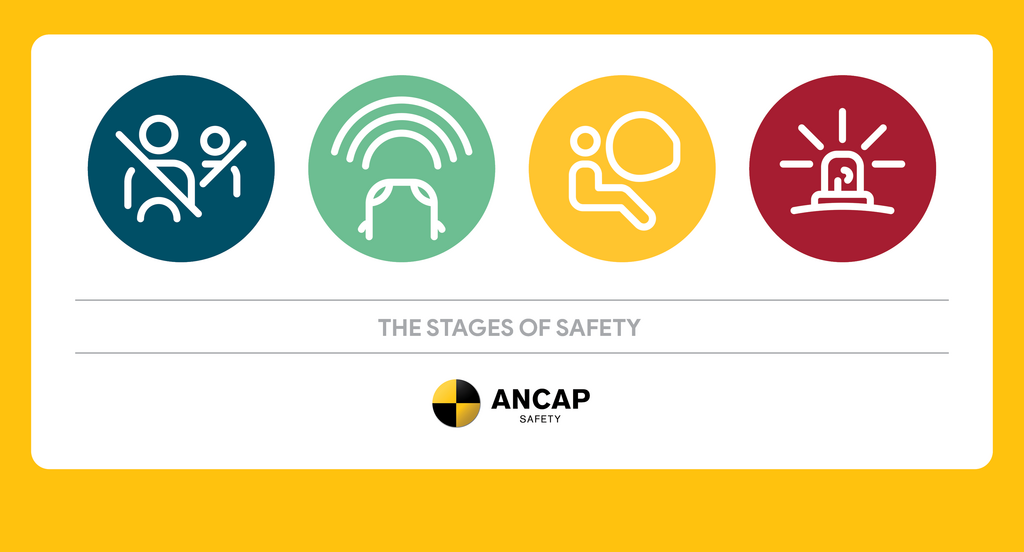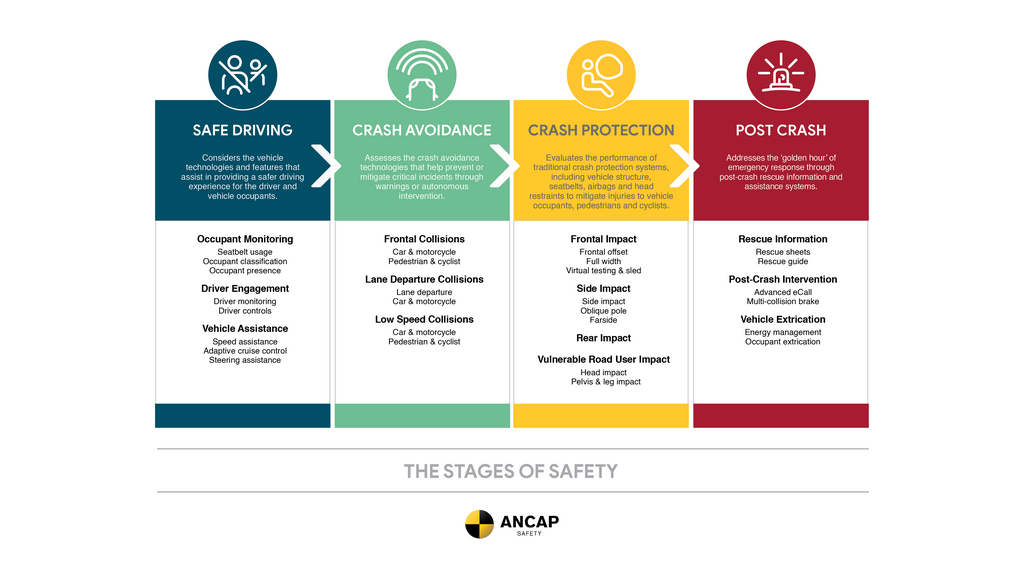
26 Nov 2025
Safety before, during and after a crash: New gen rating approach from 2026
Vehicle safety is entering a new era. Over the past 30 years, manufacturers have responded well to the safety demands of consumers, improving the structural integrity of their vehicles and, more recently, the safety technology on board.
This approach is only part of the picture when it comes to making sure road users are protected at all stages of their journey.
Last year, 1,592 Australians and New Zealanders lost their lives in vehicle-related crashes. A bleak reminder of the need for policymakers, infrastructure providers, vehicle manufacturers, enforcement agencies, advocacy groups, employers, and everyday road users to keep pushing for improved outcomes.
As part of the collective approach, vehicle safety remains a key driver in improving road safety outcomes.
From 2026, ANCAP will refresh its vehicle rating criteria - a notable update that strengthens how it evaluates the safety of new cars across the Stages of Safety: Safe Driving, Crash Avoidance, Crash Protection and Post-Crash. This approach re-organises safety assessment based on the Haddon Injury Prevention Matrix which examines what happens before, during and after a crash.
“You’ve spoken and we have listened. The Stages of Safety approach will allow ANCAP to incorporate useful feedback, enhance existing tests and incorporate new areas of focus,” ANCAP Chief Executive, Carla Hoorweg said.
“This new approach also provides a structure that can adapt to the technological developments that will shape the automated driving future.”
Developed in collaboration with Euro NCAP’s leading vehicle safety experts, the contemporised approach to independent vehicle safety testing provides a shared international benchmark - ensuring Australians and New Zealanders continue to benefit from the world’s most advanced crash testing and assessments.
Every three years ANCAP re-examines the star rating criteria with a sole focus on reducing vehicle-related deaths and serious injuries. The 2026-2028 protocols further strengthen the rigour and relevance of the tests, rewarding vehicles that perform well across all stages of safety - before, during and after a crash.
Several changes have been made specifically in response to consumer feedback. Active driver assistance systems – often criticised for their abrupt or irritating interventions – will be rewarded for smooth, intuitive operation as well as technical performance.
Increasingly popular electrically-operated door handles – which sit flush with bodywork when not in use – should remain operable after any crash. Electric cars should isolate their high-voltage battery after a serious crash, and the vehicle should be able to notify first responders of the crash.
As part of aligning testing with the consumers’ experience, ANCAP will be performing more on-road testing to better track the real-world capability of the technology on board. This on-road evaluation will examine how well the vehicle’s technology reads and responds to road conditions, and will give ANCAP more detailed insights into a driver’s experience beyond the test track.
The updates ensure ANCAP’s testing, analysis and ratings remain the authoritative guide for consumers and fleets which value independent information on the safety of the latest cars, SUVs, utes, and vans.
“Our role is to continually push for improvements in all areas of vehicle safety, and our 2026 protocols reflect that.
“The outcome will be better protection of vehicle occupants and those around them, through the active prevention of crashes, superior protection in the event of a crash, and improved post-crash management.”
2026: Stages of Safety at a Glance
The four assessment areas evaluated from 2026, known as the Stages of Safety, are:
1. SAFE DRIVING – Considers the vehicle technologies and features that assist in providing a safer driving experience for the driver and vehicle occupants.
2. CRASH AVOIDANCE – Assesses the crash avoidance systems that help prevent or mitigate critical incidents through warnings or autonomous intervention.
3. CRASH PROTECTION - Evaluates the performance of traditional crash protection elements, including vehicle structure, seatbelts, airbags and head restraints to mitigate injuries to vehicle occupants, pedestrians and cyclists.
4. POST CRASH - Addresses the ‘golden hour’ of emergency response through post-crash rescue information and assistance systems.
Each of the four stages will be scored out of 100 points and - as is currently the case - expressed as a percentage for consumers seeking that next level of information beyond the simple star rating. Minimum thresholds will also continue to apply for each stage – determining the overall star rating.
Acknowledging post-crash response time that plays a critical part in crash survival, from next year ANCAP will place greater emphasis on the availability and performance of eCall systems. More than 40 percent of all new vehicles sold in Australia in 2024 featured technology capable of automatically connecting with emergency services following a crash, known as eCall.
“Our updated protocols set a clear benchmark for emergency call systems fitted in vehicles. We want to encourage manufacturers to enhance existing systems and provide an incentive for all brands to fit this life-saving technology,” Ms Hoorweg said.
Despite this progress, deployment of eCall technology remains limited in New Zealand, with fewer than 10% of new vehicles sold last year equipped with the system.
“New Zealanders should not be left behind when it comes to life saving technologies such as eCall, the potential for it to make a difference on New Zealand’s road is too big for manufacturers to ignore.
“Through these upgraded protocols, ANCAP is setting a clear bar that will continue to challenge industry beyond regulation, inform consumers, and help reduce road trauma.
“Our goal remains focussed: helping you stay safe, every drive.
“We look forward to seeing vehicle manufacturers continue to meet the highest levels of safety in a competitive market,” Ms Hoorweg added.
To learn more about the changes see: FACT SHEET: What’s New From 2026?

Corporate Affairs Manager
0477 296 924
Large Utes.
Does size matter?
Light Trucks.
How do they compare?
Thinking electric?
Our future can be safe AND green.
Commercial vans.
Are you delivering on safety?
Stay in the know.
Sign-up for the latest ratings and news.
Ask an expert.
Your vehicle safety questions, answered!